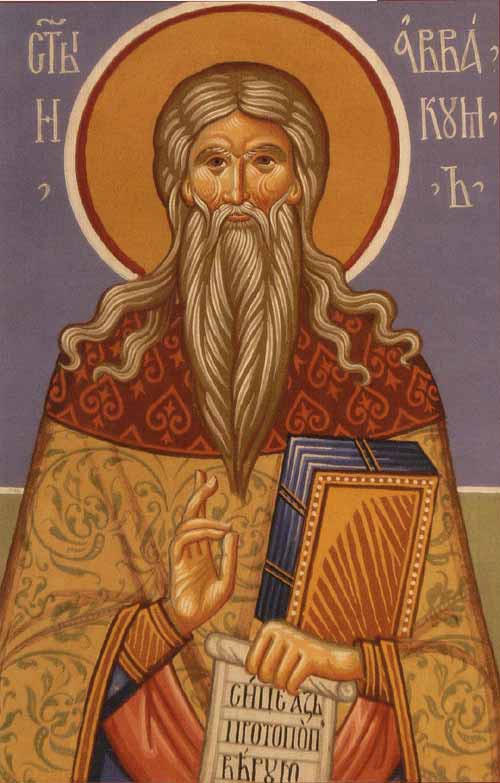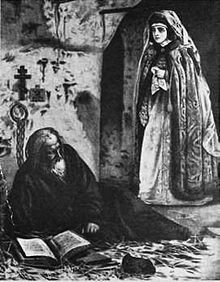Avvakum
Avvakum Petrov ( (Russian Аввакум Петров ) * November 20, 1620 or 1621 Grigorowo, southeast of Nizhny Novgorod, † April 14, 1682 in Pustosjorsk on the Pechora, today Nenets Autonomous District ) was Protopope and one of the leading figures of the movement the Old Believers, as well as an important representative of Old Russian literature. The name corresponds to the Hebrew of Habakkuk.
Life
Avvakum was the son of a village priest. He was strict religious upbringing and had early a penchant for asceticism. In 1640 he married, in 1642, he was ordained deacon, priest in 1644 Lopatitschi. This led Avvakum a very strict form of Orthodox worship, which made him hated by the population: for example, before and during the Vespers celebration 300 prostrations to the ground, 600 Jesus Prayers and 100 prayers to the Mother of God, or a form of worship, of the seven hours instead of otherwise lasted four hours. He also drove jugglers and bear trainers from the village.
In 1646 he was therefore expelled and went with his family to Moscow, where he received an imperial act through the mediation of the confessor of the Tsar, and again returned to his village. But already in 1648 he was again expelled by the inhabitants, so that he remained in Moscow until 1652. Avvakum was Protopope in town Jurjewez - Povolzhsky, after a renewed flight after eight months, he went to Moscow at the Cathedral of the Mother of God of Kazan icon near Red Square. As Patriarch Nikon in 1652 and head of the Russian church was, it came at once to the conflict and confrontation between this and Avvakum. Patriarch Nikon introduced reforms in the rites and texts, which had the objectives to establish a unified practice with the other Orthodox Churches of foreign countries. However, many believers saw these changes as heresy and fought the reform by any means. In particular, the sign of the cross with three fingers felt Avvakum and the opponents of the church reforms as dogmatic step backwards; they saw it as a sign of another Trinity, namely the one described in the Apocalypse of John of the serpent, the false prophet and the beast ( devil irrgläubiger Patriarch, evil Tsar ) and stopped at the sign of the cross firmly with two fingers, as has been practiced it so far had. For many time this question was by no means merely outward problem underlying this were important theological differences. Two fingers symbolizing the duality of Christ, where three fingers symbolizing the Holy Trinity; because Christ, not the Trinity was crucified precisely, held the opponents of the reforms a sign of the cross with two fingers suitable for theologically more. In Old Russian ritual symbol and content, character and teaching are an inseparable unit.
Awwakun and his family were forced to leave Moscow. As he continues to relentlessly occurred against Nikon and Tsar Alexei Mikhailovich himself I. Avvakum could not moderate, he was exiled to Siberia, where he had to pull over and Yenisejsk Tobolsk until after Nertschinsk with his wife and children ( 1653-1664 ). 1664 returns Avvakum back to Moscow and is banished in the same year by mesas. The great Synod of the Russian Church imposed 1666/67 on Avvakum and his followers excommunication. Furthermore, unyielding, he finally came into exile in the far north of Russia, Pustosjorsk on the Arctic coast of the Arctic Circle. Here he wrote 1672/73 his biography. Finally Avvakum was burned on April 14, 1682 at the stake and died a martyr for his faith.
Work
Apart from its religious significance Avvakum plays an important role as a writer for the Old Russian literature. While in exile on the Arctic coast, locked in a hut, he wrote at the suggestion of his confessor 1672/73 his autobiography The Life of Archpriest Avvakum, written by himself. It is the first Russian autobiography at all, for the Avvakum only were legends of the saints as models available. The language of his report is Church Slavonic with vernacular elements. Avvakum describes in an artless, realistic language his ordeal and his fight for the true faith. However, there are also very humorous descriptions of how the portrayal of a black hen whose eggs the family supplied with food in Siberia and the most beautiful animal portrayals of the literature include at all. The general assessment of the life history of the archpriest Avvakum is seen as a literary work of art of the highest order, which exercised influence on Russian literature until the 19th century. For a long time circulated only in manuscript, the first pressure took place only in 1861, by which time the influence of the Orthodox state church was still too large - for she was Avvakum as heretics. In the 20th century, the work has been translated into several European languages, including 1930 in the German language. Avvakum also wrote letters to the Tsar and his followers, who are also an important testimony to the literature of ancient Russia. In the 1670s the book of interpretations ( Kniga tolkowanij ) was born.
Afterlife
Avvakum had a religious point of great importance in Russia, and he gathered through his uncompromising attitude towards the reforms of Patriarch Nikon a large fan base behind them. These separately wordene of the Great Church group continued to live even after death Awwakums. They were later called Old Believers, so as believers after the old faith as it was practiced before the reform Nikon, lived. They saw themselves as the real true Orthodox, while the Russian State Church considered the old rites and books as heretical and their followers as Raskolniki ( releasers ). The Old Believers ( since the 18th century, " Old Ritualists " yet listed ), began with several communities, often in remote areas of Russia where they survived all repressions until today. For them, the Protopope Avvakum regarded as a saint, he is depicted on icons with halo. 1971 eliminated the Russian Orthodox Church on the anathema against the Old Ritualists. Today, there are Old Believers in Russia, Belarus, Latvia, Lithuania, Estonia, Poland, Romania and the United States.










